Как выполнять команды от имени администратора в диалоговом окне «Выполнить»
Диалоговое окно «Выполнить» в Windows 11, Windows 10 и предыдущих версиях системы — один из самых часто используемых полезных системных элементов. По умолчанию команды в этом окне запускаются от имени обычного пользователя, однако при необходимости можно выполнить и запуск от имени Администратора.
В этой простой инструкции о способах запуска команд диалогового окна «Выполнить» с привилегиями Администратора. Также может пригодиться: Список полезных команд диалогового окна «Выполнить» в Windows.
Запуск команды диалогового окна «Выполнить» от имени Администратора с помощью сочетания клавиш
Первый и самый простой способ — использовать специальное сочетание клавиш при выполнении команды. Шаги будут следующими:
- Нажмите клавиши Win+R на клавиатуре для открытия окна «Выполнить». В Windows 11 и 10 также можно нажать правой кнопкой мыши по кнопке «Пуск» и выбрать соответствующий пункт контекстного меню.
- Введите нужную команду.
- Нажмите сочетание клавиш Ctrl+Shift+Enter
В результате введенная команда будет запущена именно от имени Администратора.
Кстати, сочетание клавиш Ctrl+Shift+Enter сработает не только для окна «Выполнить», но и для выбранного пункта в списке программ меню «Пуск» или в результатах поиска в панели задач — соответствующий элемент также будет запущен от имени администратора.
Дополнительные способы
Помимо описанного выше способа, пара дополнительных вариантов сделать то же самое:
В контексте рассматриваемой темы, возможно, вас заинтересуют материалы: Как запустить командную строку от имени Администратора в Windows 11 (подойдет и для Windows 10), Как установить программу без прав администратора.
Иногда команды в меню «Выполнить» необходимо выполнять с правами администратора, иначе некоторые действия, например, в консоли (cmd.exe) будут недоступны.

Самый удобный способ — настроить сочетание Win + R.
Чтобы меню «Выполнить» выполняло команды всегда с правами Администратора, нужно сделать следующее:
-
Зайти в меню «Локальная политика безопасности» (выполнить команду secpol.msc)
-
Найти пункт «Локальные политики»
-
Открыть меню «Параметры безопасности»
-
Найти пункт «Контроль учётных записей: все администраторы работают в режиме одобрения администратором»
-
Перейти в свойства этого пункта меню и отключить его
-
Готово. Проверено на наиболее новом обновлении Win 10. Наверняка должно сработать и на 11й. Исходный туториал вообще был для Win 8
Описанная последовательность действий проиллюстрирована на скриншотах ниже (под спойлером).
Спойлер — скриншоты








Эта инструкция — перевод ответа пользователя BrainSlugs83 на сайте с вопросами-ответами (https://superuser.com/questions/462174/winr-as-administrator-in-windows-8). Он указал настоящее решение проблемы, но почему-то его ответ не выбран решением, да и такое решение вообще мало где фигурирует.
Вообще странная ситуация: именно такое решение не получается найти в первых результатах поиска, если не знать, что именно ищешь и что такое решение точно существует, а на форумах и сайтах предлагаются варианты типа «нажимать Ctrl+Shift+Enter», поиск нужной программы в Поиске и её ручной запуск от Администратора и прочая подобная чушь.
Using the instructions here you will have the ability to open Command Prompt as administrator in Windows 10 from Start, Search, Run, taskmgr, PowerShell, and more. This application allows running commands that help you fix multiple issues, change settings, and access different files. When you stuck in anything on Windows 10 the first tool you remember is CMD. Administrative authority makes you capable to run a task in elevated mode.
We already discussed How to Launch Elevated Command Prompt on Windows 10 but now some additional ways are available for the same. So here we have come with a collection of all methods to open cmd with admin rights.
How to Open Command Prompt as Administrator in Windows 10
Here are 12 Ways to Open Command Prompt as Administrator in Windows 10 –
1] Quickest and easiest way to run cmd as admin
Step-1: Click on the Start icon.
Step-2: Type cmd.
Step-3: Press ctrl+shift+enter on keyboard.
Step-4: Once User Account Control (UAC) dialog appears, select Yes.
2] Open command prompt as administrator from Run dialog
- Press Win+R and let the Run dialog box appear.
- Write down either cmd or cmd.exe in the empty text field onward to Open.
- Press ctrl, shift, and enter simultaneously.
- Click Yes when a UAC dialog prompts to seek permission.
3] Take the help of Windows search bar
- Press Windows and S keys.
- Type “cmd”
- Click – Run as administrator.
- A UAC will prompt up for authentication; choose Yes.
4] Open Command Prompt as Administrator in Windows 10 Via Win+X menu
In the recent versions of Windows 10, you notice rather Windows PowerShell (Admin) in the Power user menu (Win+X). But for launching easily, you can replace it with Command Prompt (Admin) via a small tweak in Settings. This will help you to open cmd with administrative privilege in only 2 clicks. Here’s how –
- Open Windows Settings (by pressing Win and I).
- Select Personalization.
- Select Taskbar from the left-pane and then shift to the right.
- Toggle on the option – “Replace Command Prompt with Windows PowerShell in the menu when I right-click the Start button or press Windows Key+X”.
- From now onward, whenever you will open the Power user menu, you will view Command Prompt (Admin) in the list.
- Simply press Win+X and choose the same.
5] Open command prompt as administrator by means of Task Manager
Important – Before proceeding forward, make sure that you have signed in as administrator.
- Right-click on the Taskbar and select Task Manager or directly press “Ctrl+Alt+Esc”.
- From the menu bar, click on File option.
- Press and hold the Ctrl key and at the same time click Run new task.
- It will right away open cmd as admin.
6] Again using Task Manager
- Open Task Manager using the method given in the previous way.
- Click on File from the uppermost menu bar and choose Run new task.
- Type either cmd.exe or cmd the provided space and check the box for “Create this task with administrative privileges”.
- Click – OK.
7] Through Start menu
- Press Windows key to bring up the Start menu
- Click on # from the top.
- Select W alphabet from the list.
- Click Windows System from here and to expand its options.
- Right-click on Command Prompt, move the cursor over “More”
- Then choose – “Run as administrator”.
- When you see a User Account Control popup, click the Yes to give consent.
8] Switch PowerShell to Command Prompt
- Press “Win+X” hotkey and select “Windows PowerShell (Admin)” from the Power user menu.
- When the User Account Control shows up in the display, click the Yes button to allow it.
- In the “Administrator: Windows PowerShell”, type cmd after PS C:\WINDOWS\system32> and hit the Enter key.
- This will immediately switch the PowerShell utility to Command prompt.
9] Open Command Prompt as Administrator in Windows 10 From System32 Directory
- Press – Win+E.
- Select This PC in Quick access and then Perform a double click on “(C:)” (we assume that this is your system drive).
- Double click – Windows folder.
- From the next window, locate System32 and double-click on the same to enter it.
- Once this directory appears, find cmd.exe.
- Right click on the same and opt Run as administrator from the list.
- Finally, hit the Yes button once the UAC arrives.
- Alternatively, to get access to the location you may copy-paste “C:\Windows\System32” into the Run dialog box and hit Enter.
10] Via Run command
- Press Win+R.
- Paste
C:\Windows\System32\cmd.exein Run dialog - Hit – ‘ctrl+shift+enter’.
- Choose Yes when User account control prompt appears.
11] Create Desktop shortcut
- Right-click on the desktop.
- and move cursor on New and select Shortcut.
- A wizard entitled Create Shortcut will show up.
- Copy C:\Windows\System32\cmd.exe paste into the given area
- Click Next.
- Provide a name for this shortcut.
- Click on Finish.
- You will notice a new shortcut for the “CMD” on the desktop. Right-click on the same and select Properties.
- In the Shortcut tab, move down to the bottom and click the Advanced button.
- Mark – Run as administrator
- Hit the – OK.
- Finally, click on Apply and thereafter OK button to save the changes.
- In future, whenever you need to open command prompt as administrator, just double-click on the shortcut.
12] Assign a shortcut key to open cmd as admin
- Follow the previous method to create a shortcut key of Command Prompt and give it administrative authority.
- Right-click on the desktop shortcut and select – Properties.
- Go to Shortcut key area and click on the box located beside it.
- Now, press your preferred key from the keyboard. When you will type C and the system automatically generated a shortcut key Ctrl+Alt+C.
- Lastly, click on Apply and then OK to make the changes effective.
- To open cmd as admin, you just require hitting the shortcut key you just created.
Methods:
1] Quickest and easiest way to run cmd as admin
2] From Run dialog
3] Take the help of Windows search bar
4] Via Win+X menu
5] By means of Task Manager
6] Again using Task Manager
7] Through Start menu
8] Switch PowerShell to Command Prompt
9] From System32 Directory
10] Via Run command
11] Create Desktop shortcut
12] Assign a shortcut key
That’s all!!
Пользователи Windows часто используют команду «Выполнить» для запуска программ, системных утилит, файлов и папок. В дополнение к запуску программ с помощью команду можно использовать для запуска различных инструментов администратора.
Существует несколько способов запуска программы или приложения от имени администратора в Windows 10. Ввод имени программы в поле поиска меню «Пуск» / «Панель задач», а затем нажатие клавиши Ctrl + Shift + Enter является самым простым способом.
Большинство пользователей чтобы запустить программу как администратор, вводят имя программы в поле поиска, кликают правой кнопкой мыши на нем и выбирают «Запуск от имени администратора».
Запуск программ в качестве администратора из диалогового окна команды «Выполнить».
В дополнение к указанным выше способам в Windows 10 версии 1803, существует новый способ запуска программ от имени администратора. Начиная с апрельского обновления, пользователи могут использовать команду «Выполнить» для запуска программ от имени администратора.
Чтобы запустить программу как администратор с помощью команды «Выполнить», вам просто нужно ввести имя исполняемого файла в поле «Выполнить», а затем нажать сочетание клавиш «Ctrl», «Shift» и «Enter» (Ctrl + Shift + Enter).
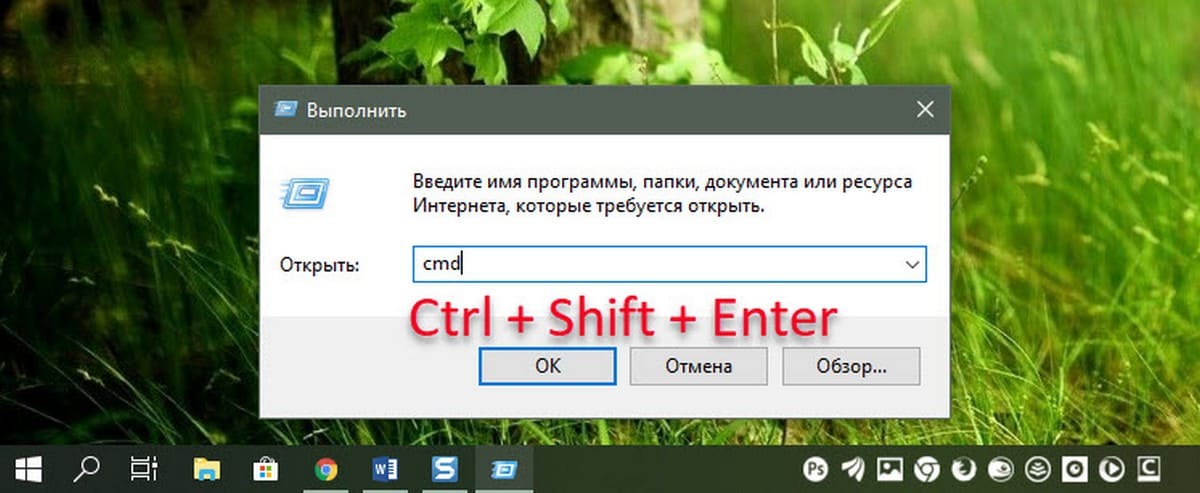
Мы считаем, что запуск программ от имени администратора легко выполнить с помощью меню «Пуск», поскольку вы можете ввести имя программы, а затем нажать клавиши Ctrl + Shift + Enter или использовать мышь.
Тем не менее, в Windows 10, теперь у нас есть новый способ запускать программы от имени администратора.
Надеюсь информация пригодится.
Рекомендуем: Сочетания клавиш для Проводника Windows 10
Комбинации клавиш для быстрого открытия приложения в Windows 10
Полезные сочетания клавиш для калькулятора в Windows 10
Немного о сочетаниях клавиш Windows 10
The Command Prompt is a powerful tool in Windows that lets you run commands to manage files, troubleshoot problems, and control system settings. But some commands require administrator access to work properly. Opening the Command Prompt as an administrator—often called “elevated mode” gives you full control to perform advanced tasks on your computer.
In this guide, we will discuss quick and easy ways to open the Command Prompt with administrator rights on your Windows 10 and 11.
Method 1: Using Windows Search (Windows 10 & Windows 11)
Note: This method is suitable for both Windows 10 and Windows 11
Step 1: Open the Start Menu and Type «CMD»
Press the Windows Key or Click on the Start Menu and Type Command Prompt or CMD and proceed ahead.
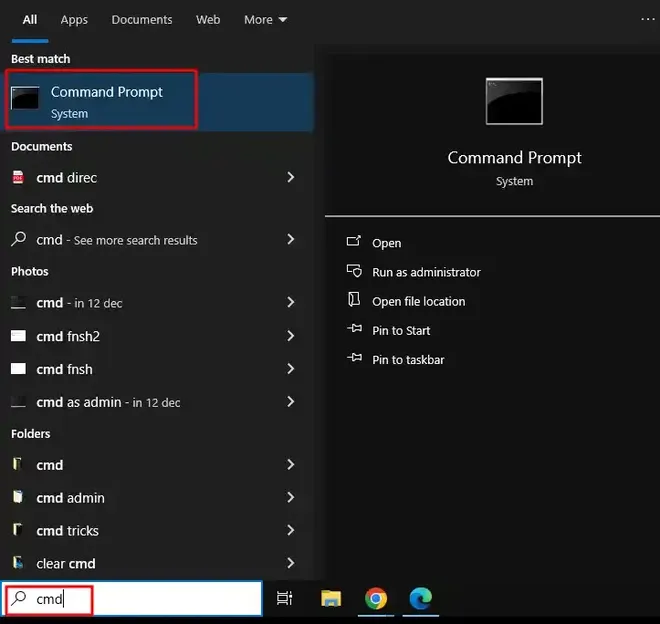
Step 2: Select «Run as Administrator»
Right-click on «Command Prompt» and select «Run as administrator».
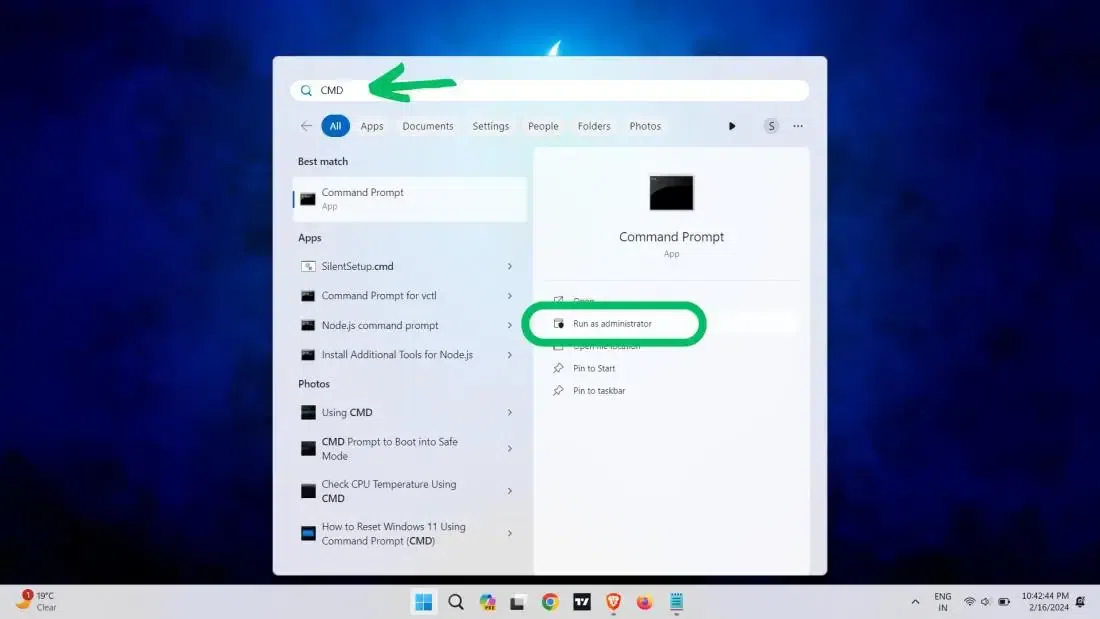
Method 2: Run Dialog Box (Win 10 & 11)
Note: This method is suitable for both Windows 10 and Windows 11
Step 1: Open Dialog Box or Press Win + R
First, press the Windows key + R to open the Run dialog. Now, type «CMD» or Command prompt
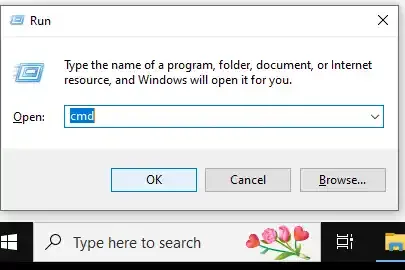
Step 2: Hold down Ctrl + Shift to enter Admin Mode
Press Ctrl + Shift + Enter or click «OK» while holding Ctrl + Shift.

You might be asked to enter admin password. Provide the same & proceed with the Command Prompt administrator rights.
Note: This method is suitable for both Windows 10 and Windows 11
Step 1: Open Power User Menu
Go to Start Button or press Win + X
Step 2: Select Admin
Now, click on «Terminal (Admin)» from the menu.
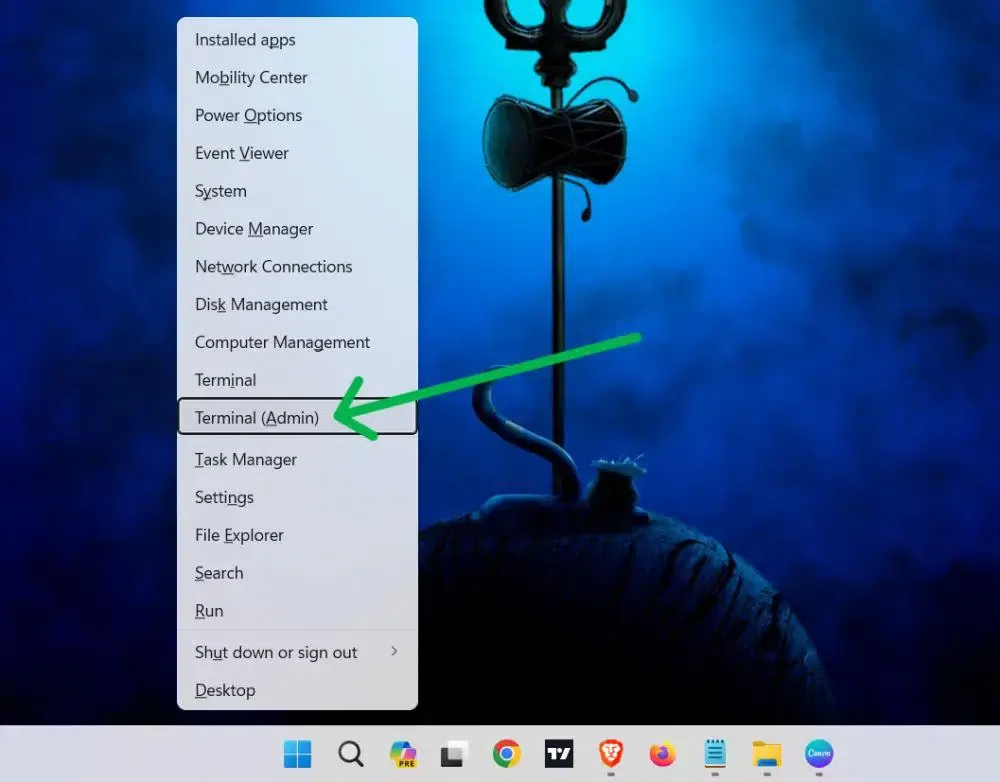
Step 3: Hover and click to visit Command Prompt
Then, Click on the arrow from the menu and Select «Command Prompt«

By following this method, anyone can open command prompt using these 3 simple steps.
Note: This method is suitable forWindows 11
Step 1: Type Windows Tools in the search box
Click on the Start menu and type Windows Tools
Step 2: Click to Open as Administrator
Make a right click and select «Run as Administrator»
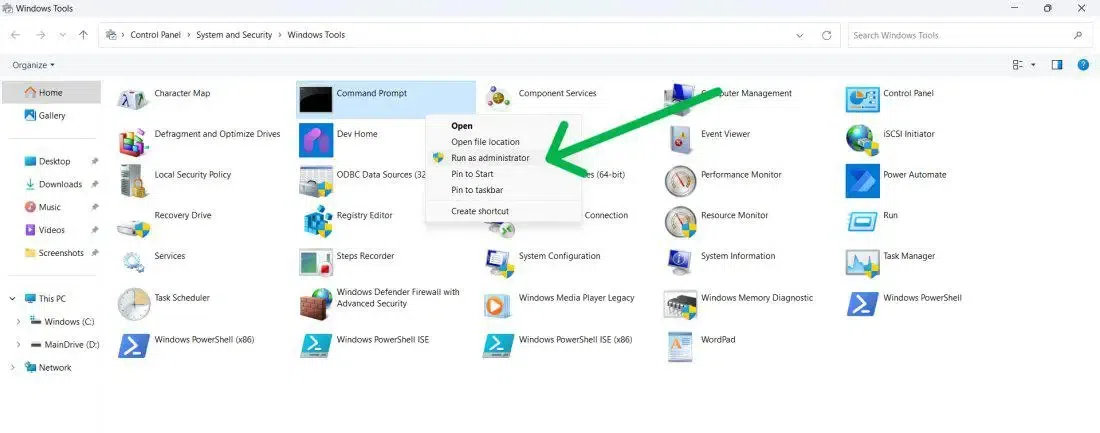
Method 5: Using Task Manager (Win 10 & Win 11)
Note: This method is suitable for both Windows 10 and Windows 11
Step 1: Open Task Manager and click to Run New Task
Click the Start Menu and type «Task Manager»
Step 2: Create a New Task to Run CMD with Administrative Rights
Create a new task in the File menu and select Run New Task. Check «Create this task with administrative privileges», and click OK.

Method 6: Use Control Panel (Windows 11)
Note: This method is suitable for Windows 11
Ypu can use Windows Control Panel to open Command Prompt with admin rights, here’s what you need to do:
Step 1: Press Win + R and type Control Panel
Now, on the Control Panel Search bar type «Windows Tools» and click on it.

Step 2: Click to Run as Administrator
Right-click on the Command Prompt and Click Run as administrator.

Method 7: Windows File Explorer
Note: This method is suitable for both Windows 10 and Windows 11
Step 1: Open File Explorer
Open File Explorer or press Win + E and type CMD
Step 2: Select «Run as Administrator»
Make a right-click and select «Run as admin»
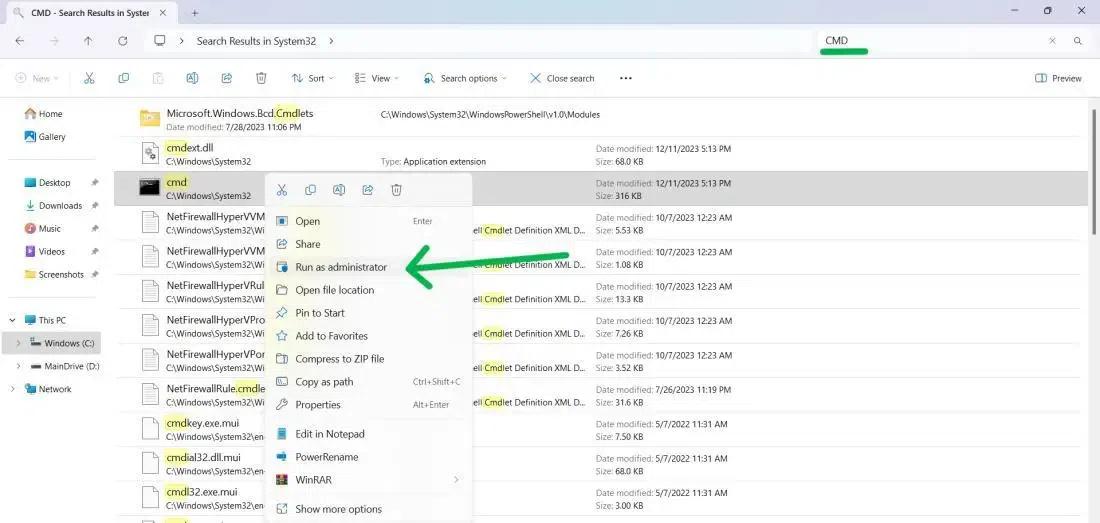
Method 8: Using Desktop Shortcut
Note: This method is suitable for both Windows 10 and Windows 11
Step 1: Open File Explorer
Press Win + E and type Command Prompt or CMD
Step 2: Show more options > Create Shortcut
Press Win + D to get the desktop then right-click CMD then from the menu select «Properties» and then navigate to the «Shortcut» tab
Step 3: Create your custom shortcut
In the Shortcut key field, press a key combination of your choice.

Why Open Command Prompt as Administrator
The Command Prompt or CMD is a powerful tool for performing various system tasks. Running it as an administrator grants you admin access to:
- Modify System Settings
- Run Admin commands like sfc /scannow i.e. system scans
- Manage User Accounts
- Access and edit restricted files
Without administrator access, many essential commands will not work, so knowing how to open it with admin access is critical for users who manage system settings, developers, or anyone performing any troubleshooting related tasks.
Conclusion
Understanding how to open the Command Prompt as Administrator is essential for both casual users and power users. Whether you’re managing system configurations, running scans, or troubleshooting issues, knowing how to run CMD with elevated privileges will enhance your ability to manage your system effectively.


